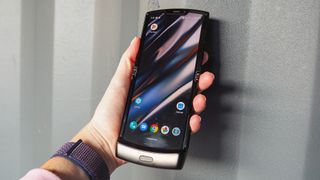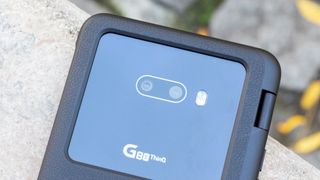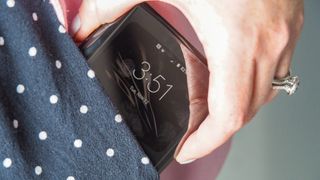Motorola Razr vs. LG G8X ThinQ: Is one folding screen better than two normal ones?
The Razr is twice the price of the G8X, but is it twice as nice?

Foldable smartphones are still in their infancy, meaning they're still expensive, and companies are hard at work trying to nail down the perfect approach. Samsung took a brave first step with the Galaxy Fold, though an overeager rush to launch resulted in some pretty egregious design gaffes that needed to be corrected. And now, the foldable baton has passed on to the Motorola Razr.
At $1,500 and exclusive to Verizon at launch, the new Razr probably still isn't that foldable handset for the masses that's going to legitimize the whole concept. And with a midrange Snapdragon CPU and a single-lens camera on the back, Motorola's phone makes quite a few concessions to hit its (relatively) low price for a device with a flexible display.
That said, the new Razr could be an important stepping-stone on the way to the foldable future the industry has promised us. And until that day comes, LG's released its own foldable of sorts — the LG G8X ThinQ, which comes with a removable Dual Screen case, all for the low, low price of $699. It can't do everything a single, bendable screen like the Razr's can, but it does have the ability to run two apps side by side in perfect harmony. Plus, LG's dual-screen phone costs less than half as much as the Razr.
How do these two very different approaches to the foldable concept measure up against each other? Let's break it down.
Motorola Razr vs. LG G8X ThinQ: Comparing specs
| Header Cell - Column 0 | Motorola Razr | LG G8X ThinQ |
|---|---|---|
| Price | $1,500 | $699 |
| Screen Size (Resolution) | Interior: 6.2-inch pOLED (2142x876); Exterior: 2.7-inch OLED (600x800) | 6.4-inch OLED (2340x1080); Optional second 6.4-inch OLED (2340x1080) |
| OS | Android 9 Pie | Android 9 Pie with LG UX |
| Processor | Snapdragon 710 | Snapdragon 855 |
| RAM | 6GB | 6GB |
| Storage | 128GB | 128GB (expandable up to 2TB) |
| Rear Camera | 16 MP (ƒ/1.7) | Dual: 12 MP primary (ƒ/1.8); 13 MP ultrawide (ƒ/2.4) |
| Front Camera | 5 MP (ƒ/2.0) | 32 MP (ƒ/1.9) |
| Battery | 2,510 mAh | 4,000 mAh |
| Size | Unfolded: 6.77 x 2.83 x 0.27 inches; Folded: 3.7 x 2.83 x 0.55 inches | Phone: 6.27 x 2.98 x 0.33 inches; Phone with case: 6.53 x 3.33 x 0.59 inches |
| Weight | 5.19 ounces | Phone: 6.77 ounces; Phone with case: 11.68 ounces |
| Color | Noir Black | Aurora Black |

Motorola Razr vs. LG G8X ThinQ: Design
We haven't yet had the opportunity to place the new Razr side by side with the G8X ThinQ in its full Dual Screen guise, though we imagine the pairing would look pretty comical. That's because the Razr folds down to half the height of an ordinary phone, and the G8X — even when shut — is the equivalent of two handsets stacked atop each other.
These are two very unique phones that don't look or feel like anything else out there. And while the cynicism around foldable phone prices is justified, it must be said there's a reason these kinds of devices are as expensive as they are. The Razr might be twice as pricey as the G8X, but it packs down into a fraction of the size.

You'll see a rather pronounced chin at the bottom of the Razr, which houses the phone's antennas and other circuitry, as well as an embedded fingerprint sensor. It might look like an eyesore, but it's nothing if not true to its predecessors — the original Razr had the very same bulge.
Motorola and Lenovo slaved over the design of the Razr's hinge alone for four years. The resulting approach employs a pair of metal plates that split apart above and below the crease to bolster the weakest point of the flexible display and keep everything tight. We won't just take their word for it, of course — we look to (responsibly) test the phone's durability in our review. Still, we're getting the impression Motorola has learned a few things from Samsung's build quality missteps with the Galaxy Fold.

Meanwhile, you don't really need to worry about the G8X's hinge all that much, because it's part of a removable case that can effortlessly be pulled off the phone. The case itself is pliable but reassuring in its heft, and the hinge can rotate 360 degrees, which adds some versatility to LG's design. With the case off, the G8X is merely a normal 6.4-inch Android smartphone. With it on, good luck trying to get it to fit into your jeans pocket — this thing is a monster, tipping the scales at more than 11 ounces.
Motorola Razr vs. LG G8X ThinQ: Display
The Razr's plastic OLED screen measures 6.2 inches from corner to corner and employs a 21:9 aspect ratio. The screen follows the overall curvature of the phone, and there's a notch up top, which holds the earpiece and front-facing camera.
The main potential issue with this screen — at least on paper — is its low resolution. At 2142 x 876, the Razr's panel can only be classified as HD+. Even most midrange handsets today pack Full HD+ displays, so this is a tough pill to swallow in a device that costs so much. On the exterior, there's a secondary, 2.7-inch, 800 x 600 screen designed for quickly accessing Google Assistant, responding to messages and taking a selfie without forcing you to open the device.

Conversely, the G8X ThinQ touts a 6.4-inch OLED display, at Full HD+ quality. That translates to about 403 pixels per inch, which is a fair bit denser than the Razr's 373 pixels per inch. The extra panel in the Dual Screen case is identical to the one in the phone, though there's still a slight difference in color calibration if you look hard enough. It's a consequence of manufacturing, and will vary slightly on every unit.
Anyone who followed the Galaxy Fold debacle knows how fragile plastic-covered displays can be. Samsung's foldable originally launched with a protective film over top that wasn't designed to be removed, though some reviewers did so anyway. When the Fold was relaunched, Samsung amended the design by securing that film underneath a bezel. Similarly, the protective layers that shield the Razr's screen are flush with the sides of the phone — meaning you won't be able to pick at it, and everything should stay put.

Motorola Razr vs. LG G8X ThinQ: Cameras
Motorola is honest with itself that the new Razr is a "design-focused" phone, and so camera quality probably isn't highest on the company's list of priorities. That's at least the sense we get, judging by the handset's 16-megapixel, single-lens exterior shooter and paltry 5-MP selfie cam at the top of the phone’s interior display.
What few shots we were able to take with the Razr during our initial hands-on session didn't look phenomenal, though Motorola has gifted the primary sensor with its Night Vision software for improved low-light imaging.
The G8X ThinQ has two lenses on its back — a 12-MP primary one and 13-MP secondary camera with a 136-degree field of view for ultrawide shots. There's also a 32-MP shooter notched within the display, with Quad Bayer pixel binning for 8-MP output with increased light sensitivity. That all doesn't sound too shabby, and yet none of these optics produced particularly impressive shots in our testing, trending toward overly bright, unsaturated results with wonky white balance and lots of distortion when capturing ultrawide landscapes.
The G8X's cameras aren't outright bad, but they're no match for the iPhone 11's or the Pixel 4's — so Motorola may actually measure up quite favorably with its Razr.
Motorola Razr vs. LG G8X ThinQ: Performance

The Razr's Snapdragon 710 CPU puts it in the same league as the likes of Google's Pixel 3a and, funnily enough, Motorola's just-released $449 Motorola One Zoom. Those handsets feature Snapdragon 670 and 675 silicon, respectively, so the 710 processor in the Razr is a bit faster than them, but not nearly as quick as 855-powered devices, which include the G8X.
Motorola has tried to mitigate this by giving the Razr a somewhat-generous 6GB of RAM — the same amount of memory found in LG's handset. Even so, we don't expect the foldable to deliver performance that’s on par. On the system-wide Geekbench 5 benchmark, the G8X delivered a multicore score of 2,704. For reference, the best result the Snapdragon 675-powered Motorola One Zoom could muster was 1,600. Perhaps the Razr will draw closer, but not significantly so. That leaves you with an ultra-premium-looking smartphone that should be sprightly enough for everyday use, but not particularly well-positioned for gaming or strenuous multitasking.
Motorola Razr vs. LG G8X ThinQ: Battery life
The one upside to Motorola selecting a midrange Snapdragon chipset is that it could wind up being more efficient than the 855 would've been. And the Razr needs to squeeze as much juice out of its battery as possible, because at 2,510 mAh, its power pack is pretty tiny by modern phone standards.
Compare that to the G8X's gargantuan 4,000-mAh power pack, which thrusted LG's device to a very respectable 11 hours and 49 minutes of LTE web surfing in Tom's Guide's custom battery test — good enough to land the G8X on our list of longest-lasting smartphones — and things aren't looking great for the Razr. Though, to be fair, the G8X delivered only 4 hours and 56 minutes when both displays were on, so you'll have to forgo the second screen if you want to get that kind of life out of LG's device.
Motorola Razr vs. LG G8X ThinQ: Software

Android 9 Pie ships out of the box on both the Razr and G8X. That's a little disappointing, considering Android 10 has been out for months now for Pixel owners. Presumably, Motorola and LG will deliver updates in the first half of next year for their respective devices, but when, specifically, is hard to say.
Still, the Razr and G8X feature an assortment of software customizations and tools to help you get the most out of them. The Razr's Quick View display offers glanceable information and shortcuts to full apps when the device is unfolded. For example, you can indicate your intention to reply to an email from the exterior display, and when you open the phone, Gmail will be ready and waiting to compose.

Using the G8X is pretty straightforward as well, like having two phones joined at the hip, that can each run their own apps and work independently of one another. That's not to say LG hasn't built in some clever software, like a keyboard tool that screenshots whatever is on the opposite display and attaches the image to a text or email you're typing. A simple three-finger gesture allows you to shuffle content between screens, and when gaming, you can use one of the panels as a software controller.
Motorola Razr vs. LG G8X ThinQ: Price and availability
The new Razr costs $1,500, comes in one configuration — Black Noir with 128GB of storage and 6GB of RAM — with pre-orders starting at Verizon on Dec. 26. Expect the phone to reach stores this coming January. For the moment, the foldable is a Verizon exclusive, and it is unclear if the device will ever make it to other carriers, let alone be sold unlocked, though Walmart will offer it in January.
The G8X ThinQ slides in at a price much friendlier to your wallet, at $699 (and that's with the Dual Screen case included.) Sprint and AT&T offer the phone on contract, though it's a bit more expensive through those carriers. We recommend going the unlocked route, as B&H and Best Buy both offer the handset for $699 with compatibility for all major carriers, no matter whether they're based on the GSM or CDMA standard.
Outlook
Ultimately, these are two vastly unique interpretations of what constitutes a foldable phone. There's no denying the Razr is the more futuristic of the two, and indicative of where the industry is headed. The prospect of a phone that's tiny enough to sink to the bottom of your pocket, but unfold into a massive 6.2-inch panel when you need it, sounds really enticing.
The problem is, it's just too expensive right now. Motorola had to make a lot of concessions even just to come in at nearly $500 less than the Galaxy Fold. That leaves us wondering whether the Razr really makes sense as a long-term investment — a phone you can honestly expect to live with every day for a few years.
The G8X seems like a more pragmatic bet, thanks to its power, durability and battery life advantages — less exciting though it is. It's also the option better suited for multitaskers, because of the ability to run different apps on each screen. The Razr can use Android's built-in software split-screen view, but it doesn't compare to the versatility of having a whole second display at your disposal.
Granted, we can't pass judgment on the Razr until our full review, so keep an eye on Tom's Guide as we near Motorola's launch in January.
Sign up to get the BEST of Tom’s Guide direct to your inbox.
Upgrade your life with a daily dose of the biggest tech news, lifestyle hacks and our curated analysis. Be the first to know about cutting-edge gadgets and the hottest deals.
Adam Ismail is a staff writer at Jalopnik and previously worked on Tom's Guide covering smartphones, car tech and gaming. His love for all things mobile began with the original Motorola Droid; since then he’s owned a variety of Android and iOS-powered handsets, refusing to stay loyal to one platform. His work has also appeared on Digital Trends and GTPlanet. When he’s not fiddling with the latest devices, he’s at an indie pop show, recording a podcast or playing Sega Dreamcast.
